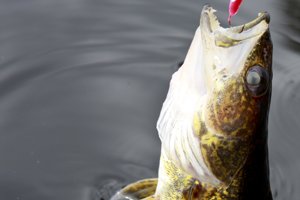
Buffalo, N.Y. — If the 2014 Lake Erie walleye catch rate is any indication, this season is shaping up to be another outstanding one for trollers, drifters and casters seeking the big lake’s marquee fish.
Several solid year classes of walleye will also factor into the fishing equation this year, DEC officials said.
“We are looking at two really strong year classes going into 2015,” said Don Einhouse, Lake Erie Unit Leader for the state’s Department of Environmental Conservation (DEC). “The 2012 year class was very strong and those should all be legal fish by the time opening day rolls around May 2. In addition, the 2010 year class was another very good one, a class that was very important to anglers last year. Those will be 5-year-old fish this year, averaging 20 to 22 inches long.”
Einhouse is also hopeful that the year class from 2013-14 is strong, too. After a long, cold winter with heavy ice cover, those conditions have a tendency to favor spawning success. Spring nettings this spring will determine that. Ditto for the 2015 spawning season on the heels of this past winter; DEC won’t be able to gauge success from this year until spring of 2016.
Einhouse is optimistic that local walleye populations will see decent spawning success for back-to-back years.
Word circulated quickly around fishing circles last year that the bite was on for walleyes in Lake Erie.
“Overall fishing effort for last year was 371,000 angler hours,” Einhouse said.“This was the highest level we’ve seen since 2001, and half of all that effort came from walleye fishermen. When you combine that with the best catch rate that we’ve seen in the 27-year history of DEC’s Lake Erie boat creel survey, you can see why the forecast is good going into this year.”
The creel study on the lake, conducted from May to October, showed that walleye were at a record level as far as catch rates, with a total harvest of 62,000 fish – the highest since 1989. The catch rate was 3.4 walleye per hour of fishing effort last year. In 2013, that catch rate was 2.2 fish per hour. “Not only did the season start out strong,” said Einhouse, “it seemed to last longer, as well.”
The big question put forth by DEC, as well as anglers on the lake, is how much of an impact the local population of walleyes represents in that creel census when combined with the migrant school of ’eyes that move over from the lake’s western basin. According to Einhouse, the local population of fish (resulting from natural reproduction in places like Van Buren Bay and Smokes Creek) seems to be improving. To be sure, New York will be part of a basinwide acoustic telemetry study that will track movement throughout the lake.
Using acoustic receivers anchored to the bottom of the lake from New York to Ohio, biologists will be tagging fish and monitoring their movements over the next three years.
“We are going to be tagging our first fish this spring in New York,” Einhouse said. “The western basin of the lake has been tagging fish for two years. Hundreds of fish have already been outfitted with tags so far. We are excited by this study. This will gather up some hard evidence on fish movement and give us plenty of information that we’ve never had before. This is better than a jaw tag study because we don’t have to rely upon anglers turning tags back into us.”
Funded by the Great Lakes Fishery Commission, the study will be able to collect not just movement data but preferred water temperatures and habitat preferences during different times of the year. The data won’t be seen until researchers pull the receivers in the fall at the end of each study period. The receivers will be placed in a variety of depths, out as deep at 200 feet.
New York’s angler effort and harvest data for walleye is also compiled with companion data from neighboring states and the Province of Ontario to produce annual lakewide assessments of the status of these fish and provide essential information for establishing safe harvest limits across jurisdictional borders. This is used by the Lake Erie Committee of the GLFC to establish a Total Allowable Catch (TAC) for the lake, which also includes commercial fishing.
For 2015, the TAC on the lake will be 4.114 million fish, up slightly from the 4.027 million that was established for 2014. Each Lake Erie jurisdiction is responsible for implementing their portion of the TAC.


 Edited
Edited